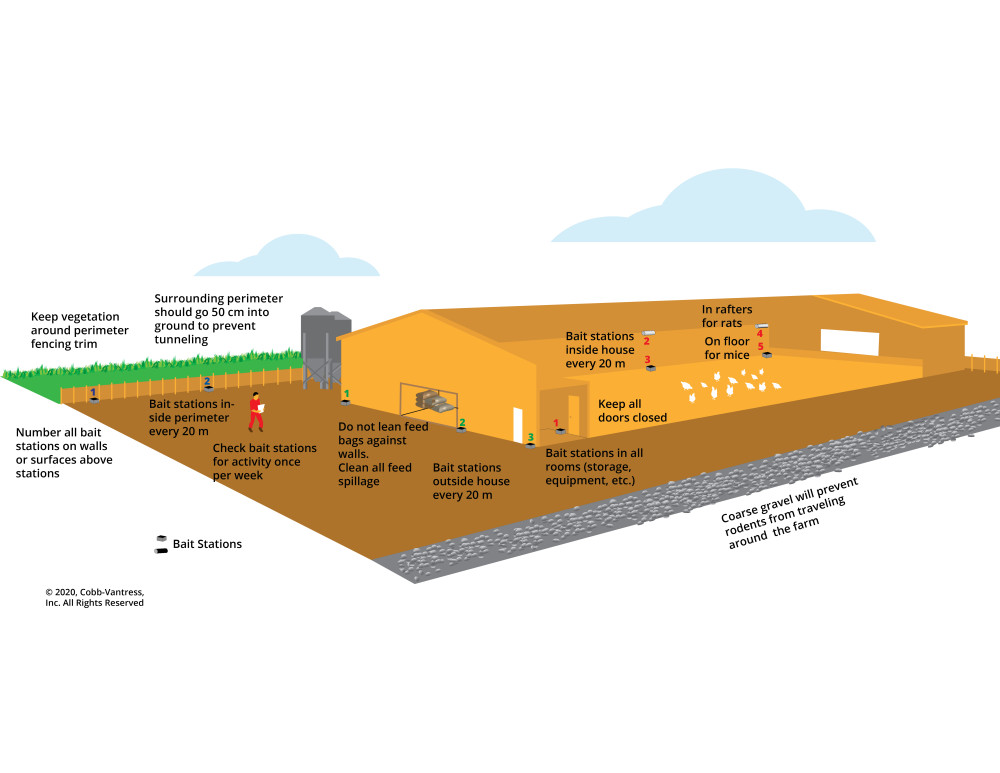Rodents are a major threat to poultry and human health. Amin Suyono discusses how to recognise rodent infestations and effective control measures.
Do you have rats?
I often ask this question to farm managers when I visit their farms. Most of them answer yes, while showing an innocent expression and giving some excuse about chickens and rats naturally living together. Another excuse I hear is that the farm area is surrounded by agricultural farms and it’s not possible to keep rats away. People make it sound like it is common or normal to have rats in chicken farms.
Rodents, however, are real enemies of your chicken farm, and they must be kept away from your houses, hatchery and feed mill area. Rodents can transmit many kinds of diseases such as Salmonella, Pasteurella, Yersinia and Leptospira. A single rat faecal pellet can contain 223,000 Salmonella Enteritidis bacteria, and more than 100 pellets can be defecated by a single rat within a day! Even after the house has been cleaned, these bacteria can remain infectious to the chicken for up to ten months.
Rodents also pose a serious fire risk to the farm by damaging electrical wiring and can remove insulation from ceilings and walls.
Domestic rodent identification
Three kinds of rodents can be found at poultry farms: the roof rat (Rattus rattus), the Norway rat (Rattus domesticus), and the house mouse (Mus musculus). Roof and Norway rats appear similar, but you can tell them apart by looking closely at their physical characteristics.

Figure 2: Symptoms of rodent infestation – gnawing on the curtain (left) and droppings (right).
How to recognise the presence of rodents
There are many ways to recognise the presence of rodents such as droppings, tracks, gnawing marks, burrows, runways, grease marks, urine stains, rodent sightings, sounds and rodent odours. Normally we do not see rodents in the daytime. They are active at dusk and at night and hide during daylight hours. Daylight sightings indicate a large rodent population.
How to control rodents
It is essential to eliminate rodents from farm facilities. A comprehensive rodent control programme must be applied on the farm. The following three methods should be used together at the same time to achieve good rat control;
Sanitation
Sanitation is very important to avoid rodent problems. Rodents come to farm facilities because they can get all of their basic needs met; including food, water and shelter. You must create a condition to prevent them from reaching their basic needs at the farm. Rodents do not like exposed situations. Surround all buildings by a one to two metre wide concrete walk-way. Remove all rubbish and overgrown vegetation from outside the buildings and off the two metre walkway. Keep weeds and grass short and tidy around the farm. All rubbish must be placed in rodent proof containers.
Clean up spilled feed immediately and dispose of it away from the farm. Implement the 5S management program as a part of your rat control process. Ensure all bagged feed is stacked tidily on pallets off the floor and away from the walls. An adult rat will eat 15 grams a day (and contaminate even more) – with a 1,000 rats on the farm this is nearly 5 tonnes per year.
Rodent-proofing
Rodent proofing is recommended to keep rodents from entering your facilities. Determine the perimeter surrounding the houses and build a fence or install a zinc-sheet or other metal sheet to prevent rats from climbing the fence and house walls.
Electrical shockers can be placed around the house building, and some companies use double electrical shockers to keep poultry houses protected from rats.
Mice can travel through a 10mm diameter hole. Keep the gap between the doors and floors smaller than this to keep rodents from getting in. A hole that is as small as pencil diameter can be passed by mice.
Poisoning and trapping
There are two types of poisons used for controlling rodents, i.e. anticoagulant and non-anticoagulant poisons. Anticoagulant has two generations. The first generation is Warfarin, Chlorophacinone, Diphacinone, Coumafuryl and Pindone. The second one is Brodifacoum, Bromodiolone and Difethialone. Most farmers use second generation poisons to control rodents.

Figure 3: Provide a clear walkway around the perimeter of each building.

Figure 4: Bait stations should be located in the most likely places for rodents, numbered to keep better track of them and should be checked at least once per week.

Figure 5: Rat trap.
A poisoning program should be maintained by placing bait stations surrounding the farm. Ideally, a bait station is placed every 20 meters around the chicken house building and in other farm facilities such as feed storage, farm office, worker shelters, etc.
Trapping is an option too, especially when the rat population is high. You can buy many kinds of commercial mousetraps, or you can make them. Browse YouTube, and you will find many people sharing ideas for trapping rodents.
Conclusion
It is time to begin or increase rodent control techniques. Don’t wait until your flocks have serious diseases or problems which will be more costly. Remember that keeping rodents out is easier than getting rid of them.


